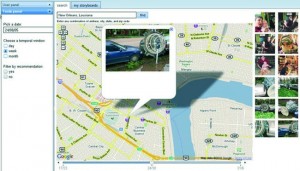A team of Spanish researchers have found a way to make emergency communication more effective with a storyboarding technique (e.g. comic books are set up like storyboards with panels of visualized information and, sometimes, text).
They published their paper in April 2011 and I’m not sure why they’ve reissued the news releases at this time but I’m glad they did.
From the March 12, 2012 news item on physorg.com,
Spanish researchers at the Universidad Carlos III of Madrid have developed a computer application that allows georeferenced images that have been uploaded to social networks on the Internet to be recovered, located on maps and organized like a comic to create a visual perspective of a specific story, such as a crisis situation or an emergency.
I prefer this description of the research (from the Research paper: eStorys: A visual storyboard system supporting back-channel communication for emergencies [behind a paywall] Authors: Malizia, A. Bellucci, A. Díaz, P. Aedo, I. Levialdi, S. Source: Journal of Visual Languages and Computing. Volume: 22. Issue: 2. Pages: 150-169. Published: APR 2011. ISSN: 1045-926X [I have removed footnotes])
In times of emergency, members of the public tend to improvise and perform various activities, such as provide first-aid to wounded people, victims transportation to hospitals or even take photos to document the event … Along with these activities, taking place physically on the disaster area, a huge number of social interaction among citizens occur. In a disaster situation people need information. They seek it for themselves and, at the same time, try to provide helpful information, such as the emergency status or damages evaluation, to other citizens, including their relatives or friends. This phenomenon is often ignored by the members of governmental agencies, which are almost entirely focused on their official role in the process of dealing with the disaster. Therefore, in such a context, people communications are considered back-channels (or peer-to-peer) activities, in contrast with the information provided by the official channels … Although back-channel communications can be viewed, in the emergency management domain, as potential vehicles to spread misinformation and rumours compromising the public safety, their presence is growing with each new disaster.
During emergencies, online social media are increasingly gaining prominence for the members of the public to find and provide information independently, or in parallel, with official channels. Social services, such as collaborative tagging systems, social networking sites or even blogs and wikis, support peer-to-peer communications. Such systems allow users to both produce and consume information about the disaster. In this way citizens can organize among themselves and share information exploiting existing technologies. This fact clearly shows how the presence of information and communications technology is changing the disaster response arena, making back-channel communications and people involvement more tangible …
Interestingly (to me), this system has been evaluated by experts in the province of British Columbia (in Canada [where I live]) and in Washington State (US). From the (undated) press release titled, A georeferenced digital “comic” to improve emergency management on the Universidad Carlos III de Madrid website,
This platform has also been evaluated through interviews with emergency management professionals in British Columbia (Canada) and the state of Washington (EEUU). “The results suggest that governmental agencies prefer to approach the social networks through more restricted communities, practice communities or special interest communities, so that the credibility of the information can guaranteed,” comments Paloma Díaz. “The lack of reliability of the information found on the social networks continues to be one of the greatest impediments to their being incorporated into the process of emergency management,” she concludes.
Nevertheless, the tool that the researchers have created can be used by anyone who wishes to compose the story of a specific crisis or emergency situation, such as a journalist, or by anyone who wishes to share their experience with others.
Also from the Universidad Carlos III de Madrid website, here’s a representation of what you might see in an estory,
They have produced a video but you will need Spanish language skills to fully understand the researcher,
If you listen carefully, you will hear Paloma Diaz say Vancouver and British Columbia. For those who prefer to (and can) read materials in the language of origin, the Spanish language press release is here.
